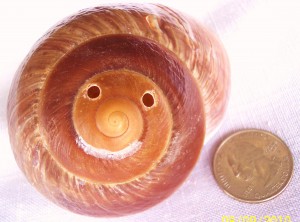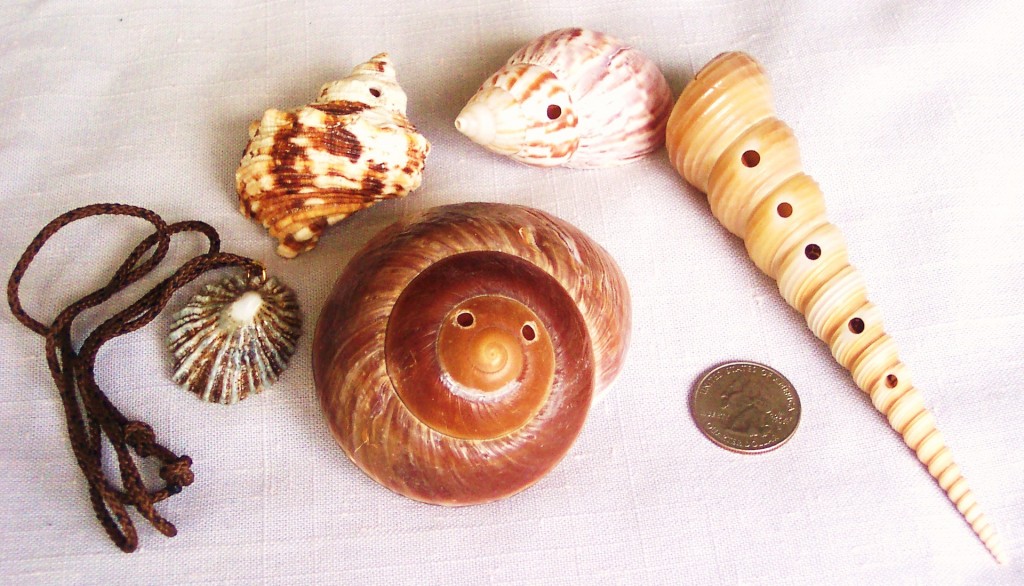Many varieties of small to medium size seashells with a round or oblong openings respond to the acorn cap whistle technique by producing their own unique sounds. These sounds often resemble animal calls such as those of the mourning dove, barred owl, loon, birds of prey and even dolphins. However, these animals will quickly lose interest if the shell player cannot imitate their calls closely.
That is why, in 2003, on a picnic table on Cape Cod, MA, I drilled one pitch hole into a six inch long Terebra Turritella, commonly known as the Great Screw Shell, and discovered that the pitch can and does change. It closely imitated the two note call of a Mourning Dove. Mourning Doves began to fly towards me as I played their song. Then I drilled more pitch holes, following the straight, lengthwise axis line of the shell, into whorls 2, 3, 4, 6 and 8. This released an octave and a half of the pentatonic and diatonic scales musical notes; and all this without the use of measurements or mathematical calculations of any sort. The shell takes care of it somehow.
In time I brought the Screw Shell Flute to Rollins College Department of Physics in Winter Park, FL. This is one of the few college physics departments in the country that studies how acoustic musical instruments work. After considerable research to verify that I was indeed the discoverer and inventor the seashell flute was accepted as a research project supported by National Science Foundation Grant #0551310 and the Rollins College Student-Faculty Collaborative Scholarship Program. They studied the seashell flute for approximately three years and then wrote a research paper for publication.
The prestigious Journal of Sound and Vibration reviewed the twenty page research paper titled “The Auger Shell as a musical instrument”. In the introduction it was stated that:
“what is most interesting about the auger shell as a whistle is that the holes drilled into the shell are placed in a straight line and that this simple arrangement allows the player to produce a diatonic scale by uncovering the holes in order. The fundamental pitch of the resulting scale is determined by the size of the shell, which ranges from approximately B to E, but the orientation of the holes is always the same.
It is not surprising that a sound can be produced by blowing across the edge of the auger shell; it would be surprising if this did not happen. What is surprising, however, is that merely by drilling a series of holes in a line down the shell one can produce the diatonic scale. This is an interesting phenomenon that indicates a special relationship between the shape of the shell and the fundamental basis of Western music”.
The conclusion states:
“we do not have a firm understanding of the air resonances of a pipe shape of a logarithmic spiral. Our data indicate that a simple model that works well for straight pipes, and pipes with a few toroidal bends, does not accurately predict the impedance of a logarithmic spiral cavity with holes. This anomalous behavior will be the subject of future research.”
I found the diatonic scale inside another species of seashell: the Muffin Shell (Rysotta Ovum). The spiral shape of this shell is closer to what is known as the Golden Mean or Fibonacci Spiral. The shape of the Screw Shell spiral resembles an Archimedean spiral. For each of these shell species I use different geometric lines of pitch holes to release the diatonic scale of notes. The Muffin Shell produces a deeper sound than the Screw Shell Flute, which sounds similar to a Native American Flute.
I offer five musical seashells for sale at certain farmer’s markets and music festivals I vend at throughout Florida. This is my first attempt to offer them for sale online. The other three musical shells are for children around seven years old and older, as two shells contain only one pitch hole each and are easier for young children to operate. The seashell whistle necklace is an extremely loud and high-pitched whistle that can imitate bird of prey calls. Children as young as six can operate it.
The player’s thumbs are used to partially cover and seal each shell instruments opening. When the player’s lips are pressed onto their thumbs, and breath is blown across the exposed shell opening edge, the shell makes sound. So the size of the shell opening cannot be larger than the size of the players thumbs pressed together. This is why customers are asked to specify their gender and approximate age when ordering so we can match the correct size shell instrument to each customer’s hand size.
Please read more about my seashell discoveries in my blog. It’s a continuing story. Thanks.


